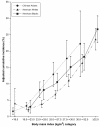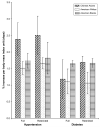Impact of body mass index on incident hypertension and diabetes in Chinese Asians, American Whites, and American Blacks: the People's Republic of China Study and the Atherosclerosis Risk in Communities Study
- PMID: 18375949
- PMCID: PMC2792196
- DOI: 10.1093/aje/kwn060
Impact of body mass index on incident hypertension and diabetes in Chinese Asians, American Whites, and American Blacks: the People's Republic of China Study and the Atherosclerosis Risk in Communities Study
Abstract
Researchers have hypothesized that the impact of body mass index on chronic disease may be greater in Asians than in Whites; however, most studies are cross-sectional and have no White comparison group. The authors compared the associations with body mass index in Chinese Asians (n = 5,980), American Whites (n = 10,776), and American Blacks (n = 3,582) using prospective data from the People's Republic of China Study (1983-1994) and the Atherosclerosis Risk in Communities Study (1987-1998). Slopes of risk differences over body mass index levels were compared among the three ethnic groups in adjusted analyses. The authors found larger associations with body mass index in Chinese Asians compared with American Whites and Blacks for hypertension (p < 0.05). The increase in the incidence of hypertension associated with a one-unit increase in body mass index over approximately 8 years of follow-up was 2.5, 1.7, and 1.8 percentage points for Chinese Asians, American Whites, and American Blacks, respectively. For diabetes, the estimates were 1.7, 1.1, and 1.6 percentage points for the same groups- higher in Chinese Asians than in American Whites (p < 0.05) but similar between Chinese Asians and American Blacks. Given the ethnic differences in associations, the results support advocacy of public health and medical actions toward obesity prevention and treatment in China.
Figures



References
-
- Hu FB, Wang B, Chen C, et al. Body mass index and cardiovascular risk factors in a rural Chinese population. Am J Epidemiol. 2000;151:88–97. - PubMed
-
- National Institutes of Health Clinical guidelines on the identification, evaluation, and treatment of overweight and obesity in adults—the evidence report. Obes Res. 1998;6(suppl 2):51S–209S. - PubMed
-
- WHO Expert Consultation Appropriate body-mass index for Asian populations and its implications for policy and intervention strategies. Lancet. 2004;363:157–63. - PubMed
-
- Misra A. Revisions of cutoffs of body mass index to define overweight and obesity are needed for the Asian-ethnic groups. Int J Obes Relat Metab Disord. 2003;27:1294–6. - PubMed
-
- Stevens J. BMI cutoffs for obesity should not vary by ethnic group. In: Medeiros-Neto G, Halpern A, Bouchard C, editors. Progress in obesity research: 9. Chap 116. John Libbey Eurotext Ltd; Montrouge, France: 2003. pp. 554–7.
Publication types
MeSH terms
Grants and funding
- N01 HC055016/HL/NHLBI NIH HHS/United States
- N01 HC055019/HL/NHLBI NIH HHS/United States
- N01-HC-55016/HC/NHLBI NIH HHS/United States
- N01 HC055015/HL/NHLBI NIH HHS/United States
- N01-HC-55021/HC/NHLBI NIH HHS/United States
- N01-HV-12243/HV/NHLBI NIH HHS/United States
- N01 HC055020/HL/NHLBI NIH HHS/United States
- N01-HC-55019/HC/NHLBI NIH HHS/United States
- N01-HC-55015/HC/NHLBI NIH HHS/United States
- N01-HC-55020/HC/NHLBI NIH HHS/United States
- N01 HC055015/HC/NHLBI NIH HHS/United States
- N01 HC055018/HL/NHLBI NIH HHS/United States
- N01-HV-08112/HV/NHLBI NIH HHS/United States
- N01-HC-55018/HC/NHLBI NIH HHS/United States
- N01-HV-59224/HV/NHLBI NIH HHS/United States
- M01 RR000046/RR/NCRR NIH HHS/United States
- N01-HC-55022/HC/NHLBI NIH HHS/United States
- N01 HC055021/HL/NHLBI NIH HHS/United States
- R01 DK069678/DK/NIDDK NIH HHS/United States
- N01 HC055022/HL/NHLBI NIH HHS/United States
LinkOut - more resources
Full Text Sources
Medical

